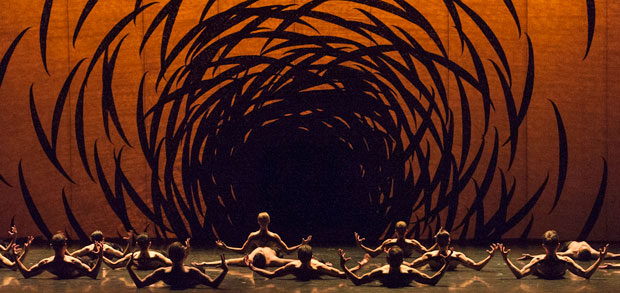
© Foteini Christofilopoulou. (Click image for larger version)
Scottish Ballet
MC 14/22 (Ceci est mon corps), Emergence
★★★★✰
London, Sadler’s Wells
7, 8 June 2017
Gallery of Emergence pictures by Foteini Christofilopoulou
www.scottishballet.co.uk
www.sadlerswells.com
Scottish Ballet’s double bill, first presented at the 2016 Edinburgh Festival, is a showcase for the company as a contemporary ballet ensemble. Christopher Hampson, its chief executive and artistic director, secured the two works last year from sought-after choreographers: Angelin Preljocaj from France and Crystal Pite from Canada, thereby putting Scottish Ballet on an international footing. Both are pre-existing ensemble works, the performers virtually anonymous on stage, though named on cast sheets: the company is the star, not the soloists.
Preljocaj named MC14/22 after the verse in St Mark’s Gospel in which Christ instructs his disciples, as he breaks bread: ‘Take it; this is my body’ – in French, ceci est mon corps. Though it is significant that there are 12 men in the cast, the same number as the apostles, any specifically Christian imagery is elusive. In an increasingly sectarian Western society, audiences probably wouldn’t spot religious iconography anyway. (It’s a potential problem for Kenneth MacMillan’s The Judas Tree, with its 12 disciples.)
On seeing MC14 a second time, it becomes evident that the structure is not a coherent narrative but an assemblage of scenes edited together, like a Pina Bausch ‘piece’. A linking theme is up to the viewer to interpret. The corps of the title could refer to the male dancers’ bodies, bare torsos beautifully lit by Patrick Riou. Sometimes the men seem moving parts in a pattern-making machine; in other scenes, they are a brotherhood or warring tribes.
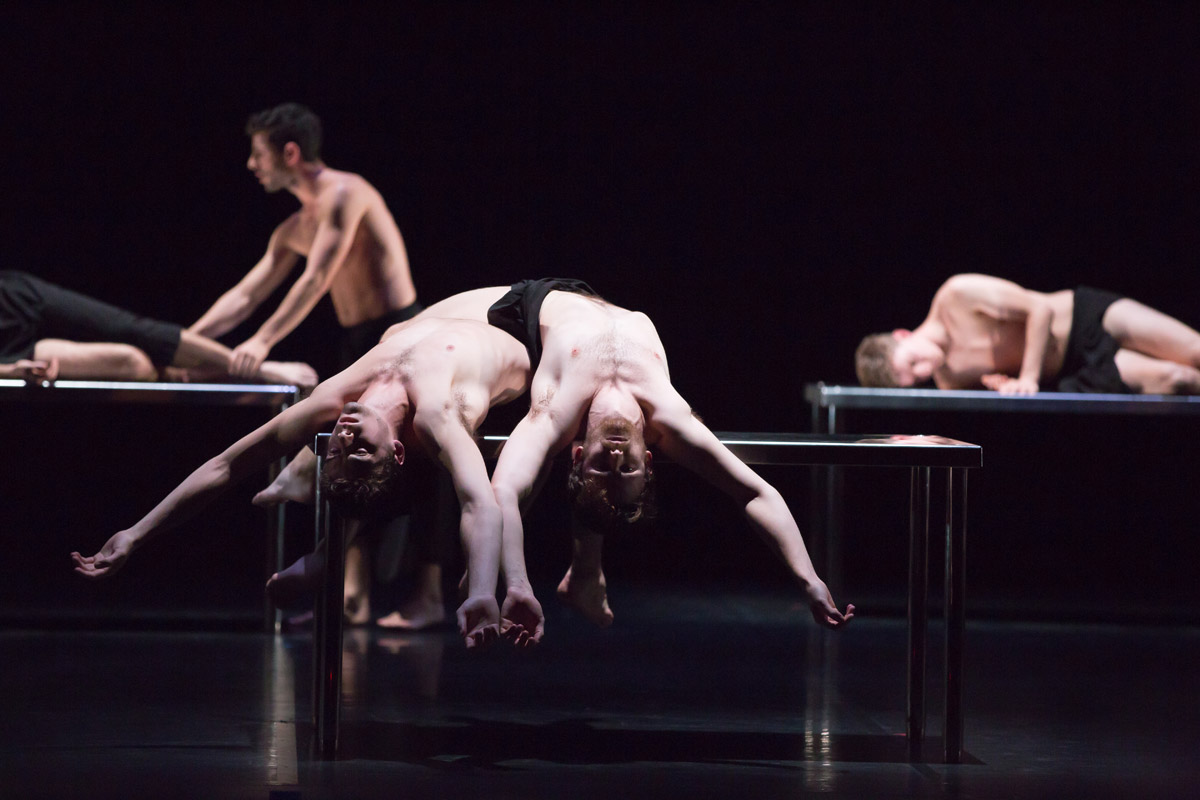
© Andy Ross. (Click image for larger version)
A prelude in silence features two men to the left of the stage, one washing the other in what may be a funerary ritual (though the corpse co-operates). On the other side, a man rips up gaffer tape to mark a square on the floor. At the back, dimly lit, is series of bunk beds or specimen cases, in which eight almost nude figures sleep or writhe. They might be waiting to be born – or prisoners in a concentration camp.
Once a taped soundscape starts, the steel frames are demounted to become tables, over and under which the 12 men disport themselves. The surfaces serve as massage plinths or autopsy tables, with solicitous attendants growing increasingly callous, until the roles are reversed and the victims resort to violence. Now we’re seeing internecine strife, neighbours setting upon each other to a racket that sounds like gunfire.
In sudden silence, the eight tables are joined in a line. To heavy metal drumbeats, the men form tableaux resembling antique paintings, lit in different colours. Their poses suggest eating (the Last Supper?), grasping (Christ expelling the money lenders?), brandishing weapons or sports equipment . . . or maybe taking selfies for Instagram images. In between each frozen arrangement, couples grapple aggressively or sexily. The sequence becomes laboriously repetitive.
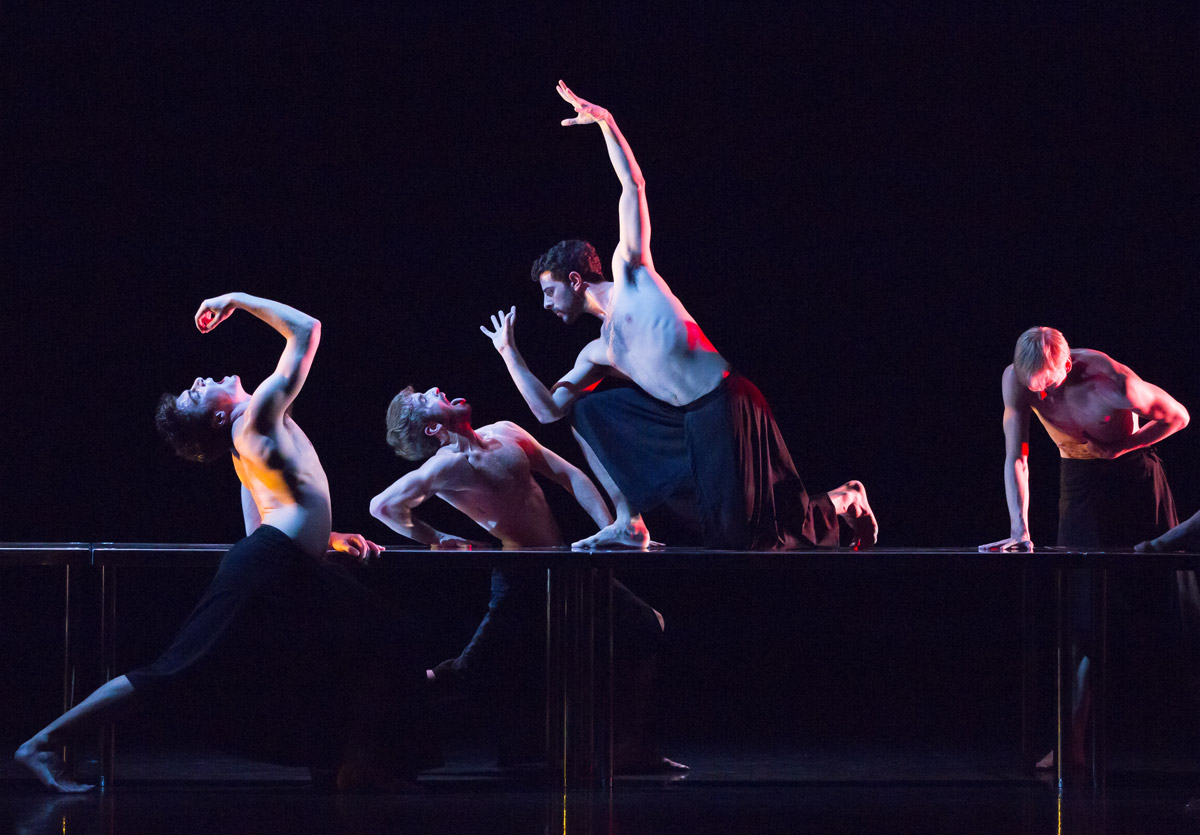
© Andy Ross. (Click image for larger version)
Nine men then stand on the conjoined tables, executing ports de bras that end in a cruciform shape. They appear indifferent to the suffering of one of their number, whose liturgical-sounding song is viciously interrupted by two torturers. Are they censoring singing or repressing religion? He survives, however, to resume his place with the others, doing synchronised gymnastics on, over and under the tables.
We can admire their discipline, which may be sinister if it’s leading anywhere. They leave the stage for the first time, abandoning two of their number. One attempts to repeat a set enchaînement of moves while the other trusses him up with gaffer tape. Easy laughter grows discomfited as the victim hops and hobbles, refusing to give up. When he falls, inert, two men bundle him off.
His extinction leads to the final scene, in which the men take turns at toppling off the piled-up tables to be caught along the outstretched arms of their mates: a trust game signifying death and resurrection? Meanwhile, a kneeling man keeps immersing his head in a bowl, blackening his face, maybe in grief. The lights go out as the cycle of falling and rising continues.
Too many questions (for me) during a protracted 55-minute work with a specific title that implies more than ‘a hymn to the male body’. In another opaque quote in the programme note, Preljocaj offers his concept of ‘a space where questions are asked and recurrent intensity is put before a world where galloping virtuality is overtaking physical experience.’ Does it make sense in French?
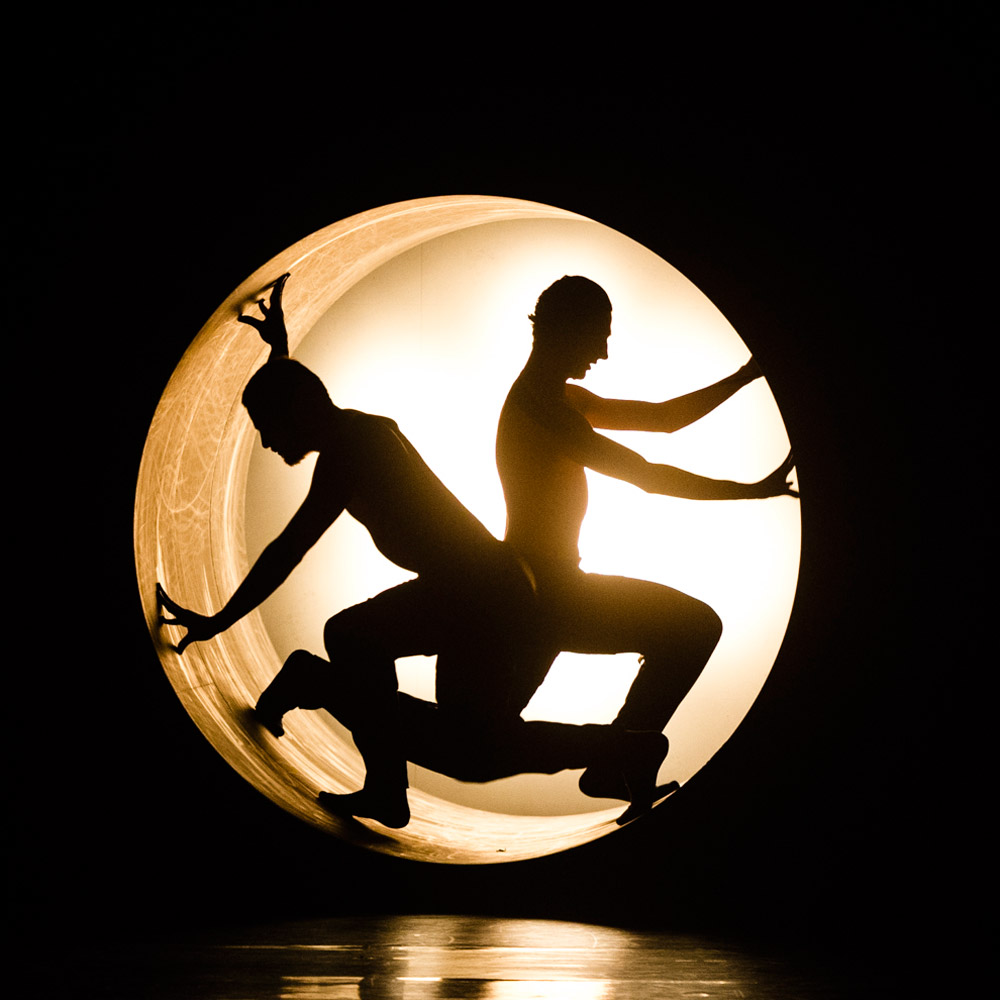
© Foteini Christofilopoulou. (Click image for larger version)
Created for Preljocaj’s own company in 2000, MC14 comes from a Tanztheater aesthetic in which cruelty is arbitrarily juxtaposed with tenderness. Hampson has programmed it with Crystal Pite’s Emergence, made for the National Ballet of Canada in 2009. It reveals her fascination with the effects of large numbers of dancers moving en masse, like her recent Flight Pattern for the Royal Ballet. The performers are driven by a herd instinct – in Emergence, by bees’ swarm intelligence, without human emotions.
The collective body, however, is a corps de ballet, opting to follow the choreographer’s instructions rather than blindly obeying animal instincts. The set is their work place, their hive, accessed by a honey-coloured tunnel at the rear. Their queen bee, Sophie Martin, emerges at the start from pupation, assisted by Evan Loudon. Her limbs are not yet under control, her wings only beginning to unfurl as he lifts her in flight. To the sound of buzzing, a swarm of masked creatures enters, not quite in unison so that they appear to be hovering.

© Foteini Christofilopoulou. (Click image for larger version)
Owen Belton’s electronic score is infinitely easier on the ear than the screeches and mutters of Preljocaj’s collaborator, Tedd Zahmal. To Belton’s pulsating rhythms, the women stalk on pointe, elbows bent in insectoid shapes. Their corseted black leotards resemble bees’ carapaces. The men’s torsos are bare, their shoulders inked with tattooes. When they lie, face down, their raised elbows make them look like a swarm of locusts ready to march.
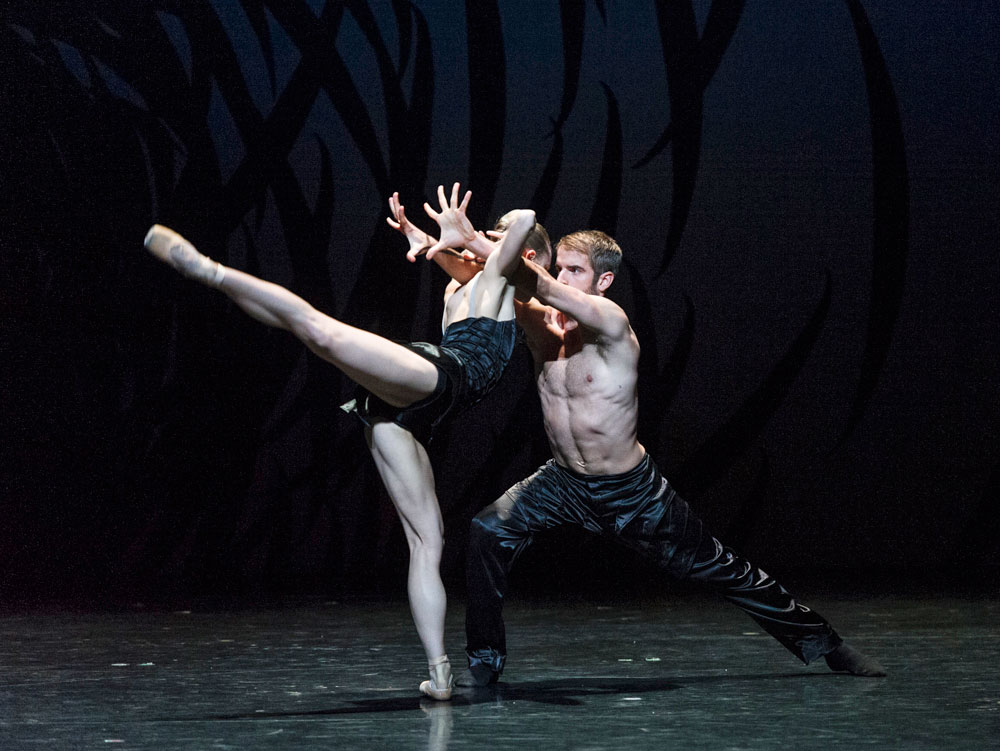
© Foteini Christofilopoulou. (Click image for larger version)
An angular duet for Bethany Kingsley-Garner and Victor Zarallo could prove fatal for him. So could an encounter between Martin and three would-be suitors. Regrouped into a line, the females appear as threatening as Wilis seeing off male intruders. Two men retreat into the tunnel, balancing within it as guardians of the hive.
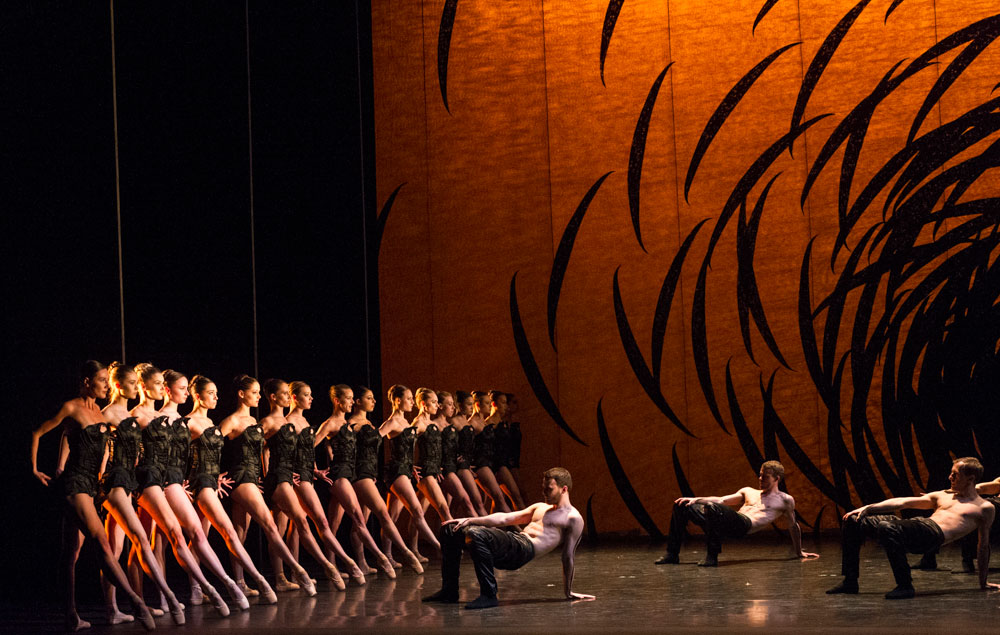
© Foteini Christofilopoulou. (Click image for larger version)
Towards the end, the ever-changing groups combine into a menacing regiment, legs held tight in throbbing relevés, arms upstretched with flexed wrists like antennae. As impressive as a massed Balanchine finale, it’s more intimidating (and less sophisticated). Because Pite’s intentions are so much clearer than Preljocaj’s, Emergence dominates the double bill. Scottish Ballet’s dancers, supplemented with students, look spectacular.












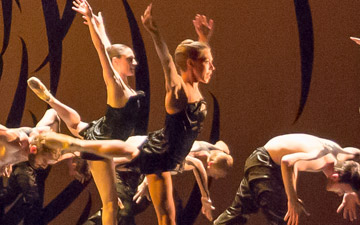
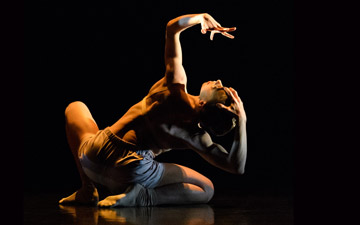
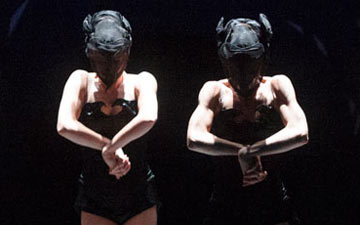
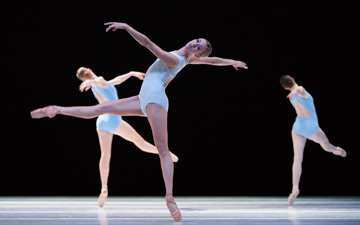

You must be logged in to post a comment.